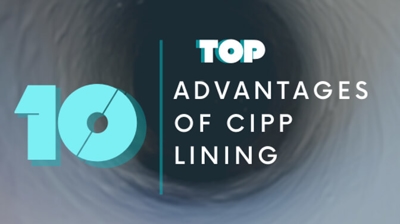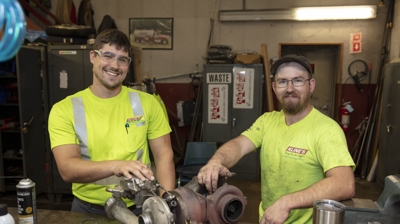Pipe Relining Services
Pipe rehabilitation is that aspect of trenchless rehabilitation that undertakes the repair or replacement of sewer and water pipelines that run under the city or town, connecting offices and industries to the municipal sewer network or water connection. Trenchless technology enables repair and replacement with little to no digging required. There are different methods for trenchless rehabilitation of pipes which are cost effective, quick, reliable, and long lasting. Trenchless repair methods are becoming more popular because they are non-disruptive and eco-friendly.
What is CIPP Lining?
Cured in place pipe lining, also known as CIPP lining, is a method of trenchless pipe repair. This process is done to preserve the current pipes that have been damaged by leaks, cracks, intruding roots, and rust. It is used to increase the lifespan of a pipe system for up to 100 years while also preserving the building structures and causing little to no damage to the property. It is also much cheaper than traditional pipe repair as well as having a faster turn around time, so little to no shut down of your business as well.
At Wind River Environmental, we are the leading expert in trenchless technologies and we bring our customers a wide diversity of pipe rehabilitation methods. While we specialize in CIPP, or cured in place pipe, lining repairs, we also have other trenchless methods to fit our customer's needs as well. We are committed to giving you a full system renewal. Please contact us, 407-481-2750, to schedule our services or speak with an expert to learn more about our trenchless pipe rehabilitation methods.
- First - We inspect the pipelines utilizing our video pipe inspection, where a CCTV camera is inserted in the pipeline and our camera operators drive it down the length of the pipeline. This allows us to not only measure the pipe but also see the extent of the damage. After the inspection is complete, our expert technicians will create an action plan to repair all your pipe problems.
- Second - Once we properly assess the damage and propose a solution, we thoroughly clean out the line with our jet vac trucks and special tools to remove all the FOG (fat, oil, grease), dirt, mud, tree roots, debris, etc. to ensure the line is completely clear before we move on to the final step.
- Third - After the pipe is cleaned we line the pipe. We saturate a new CIPP liner with an epoxy cure and insert the liner along the damaged pipeline. The liner will then inflate causing the pipe to cure in place. The end result is the creation of a strong, smooth, and seamless 'pipe within a pipe.'
Benefits of Cured in Place Pipe-lining
- Eco-friendly
- Zero digging
- Cost-effective
- Minimal clean-up
- Versatile
- Non-destructive
- Durable
- Lasts for decades
The repaired pipe is better and stronger:
Roots cannot penetrate the new “jointless” pipe and calcification won't stick to the inner walls of the epoxy barrier-lined pipe.
Pros and Cons of Pipe Relining
Damaged pipelines are among commonplace issues faced by every professional plumber. Repairs become more and more difficult as the problem is ignored or left to develop over time. When a pipe system finally blows up, you can expect a major disruption to happen in a commercial or industrial business operation. You may think that the only method of repair is to opt into a more traditional means, this would bring up images of trench digging and massive property unearthing.
However, a new zero-dig solution has arrived! Trenchless pipe repair has been around since the 1970s but really only began to take off in the U.S. recently as it is still a relatively new procedure that most business owners don't know about yet. From new drain installations, to clearing clogs, to repairing and replacing new sewer lines, trenchless repair services provide the ultimate solution to a once costly and time-consuming procedure.
Pros:
Trenchless pipe repair has many benefits over traditional methods :
Greater Time Efficiency:
Expert professionals can carry out the trenchless pipe repair method in as little as a few hours and bring your pipes back to almost new condition. You get to save time and spend it on what matters most.
Cheaper:
Lining pipes save commercial and industrial properties up to 75% in costs as compared to replacing the old pipe with a new one. The cost of labor goes down as less hours are needed to compete the trenchless process. In upfront cost comparisons the price of traditional repair is less than or equal to that of trenchless repair solutions. However, with traditional pipe repair solutions there are a number of additional costs, when compared to the trenchless repair solution, that can dramatically hike up the price and become a more timely and costly endeavor in the long run.
Versatile:
You won't have to worry about your old sewer system being made of traditional materials such as concrete, cast iron, orangeburg, or clay. Trenchless CIPP Technology works for all kinds of pipes and since the lining conforms to the shape of the host pipe, any shape (oval, rectangular, etc.) can be repaired and restored.
Zero-Digging:
Trenchless pipe repair is the preferred method because it requires zero digging. Since the job is completed without having to excavate the property it will save the property owner time and money.
Eco-Friendly:
Wind River Environmental is proud to use materials that are friendly to the environment to cause as minimal environmental damage as possible.
Durable:
The strong epoxy cure coating placed inside the pipe system provides a damp-proof, corrosion resistant, wear-resistant, and non-corrosive lining. Several coats can be applied to the same pipe, this ensures the system is fully protected and strengthened. On average, this coating is made to last up to 100 years.
Cons:
On the downside, there are rare occasions when it might already be too late to rehabilitate a pipe system using the trenchless method. The line could become irreversibly damaged and corroded to such a great extent, leaving the even the most knowledgeable and experienced professional to have no choice but to use the traditional method and dig up trenches to replace the pipes.



